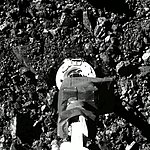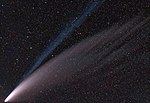2020 HS7 is a very small asteroid classified as a near-Earth object of the Earth-crossing Apollo group. When it was discovered by the Pan-STARRS 2 survey on 27 April 2020, the asteroid was initially calculated to have a 10% chance of impact with Earth before being ruled out by improved orbit determinations from additional observations.[6] Although there is now no risk of impact with Earth, it did make a close approach 42,700 kilometres (26,500 mi) from Earth on 28 April 2020, with a flyby speed of 15.6 kilometres per second (9.7 mi/s) relative to Earth.[3][7][5] The asteroid will not make any close encounters within 1 lunar distance (380,000 km; 240,000 mi) of Earth in the next 100 years.[3]
Observations by Kiso Observatory in Nagano, Japan show that the asteroid rotates extremely rapidly with a rotation period of 3 seconds, making it the fastest-rotating asteroid known as of 2022.[4] No other near-Earth asteroid of similar size is known to have a rotation period shorter than 10 seconds, which could be attributed to the tangential component of the YORP effect accelerating their rotation far beyond this period.[4] The asteroid exhibits a very small light curve amplitude of 0.07 magnitudes, which either implies a nearly spherical shape or a pole-on rotation during observations.[4]
See also
References
- ^ a b "2020 HS7". Minor Planet Center. Retrieved 15 July 2022.
- ^ "MPEC 2022-F48 : 2022 FD1". Minor Planet Electronic Circular. Minor Planet Center. 28 April 2020. Retrieved 15 July 2022.
- ^ a b c d e "JPL Small-Body Database Browser: (2020 HS7)" (2022-04-28 last obs.). Jet Propulsion Laboratory. Retrieved 29 July 2020.
- ^ a b c d e f Beniyama, Jin; et al. (2022). "Video observations of tiny near-Earth objects with Tomo-e Gozen". Publications of the Astronomical Society of Japan. 74 (4): 877–903. arXiv:2207.07071. doi:10.1093/pasj/psac043.
- ^ a b Bartels, Meghan (5 May 2020). "Tiny asteroid's super-close Earth flyby shows planetary protection in action, scientists say". Space.com.
- ^ "ESA space situational awareness 2020HS7". European Space Agency. Retrieved 29 July 2020.
- ^ Malik, Tariq (28 April 2020). "Small asteroid zips safely by Earth just ahead of a larger space rock's flyby". Space.com.
External links
- 2020 HS7 at NeoDyS-2, Near Earth Objects—Dynamic Site
- 2020 HS7 at ESA–space situational awareness
- 2020 HS7 at the JPL Small-Body Database
















You must be logged in to post a comment.